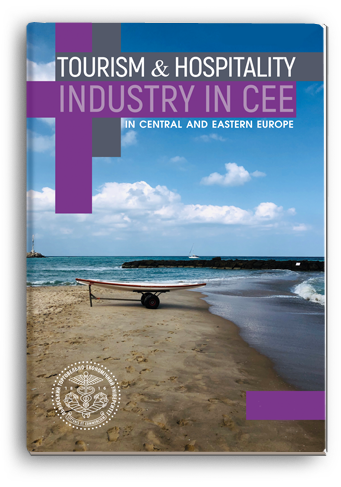Abstract
It is investigated the potential of ecological tourism in the regions of Ukraine on the basis of testing the ecological curves of Kuznets (ECC), constructed through the ratio of air emissions per square kilometer of region and gross regional product per capita. As an indicator of the tourist potential of the region, the gross value added by such economic activities as art, sports, entertainment and recreation and temporary accommodation and catering (for the period 2005-2018, in the given prices) was chosen. According to the named indicator, Dnipro, Lviv, and Odesa regions were selected as the ones with the highest share of gross value added for these types of economic activity. ECC was also built according to the data on average in Ukraine. An earlier period of the ECC turning point in the region allows us to conclude that the trend towards ecological reorientation of the population is stable. It is proved that ecotourism has prospects for development only after reaching a certain level of gross regional product, which allows the spread of sustainable "green" trends in the field of recreation. According to the results of the research, it was concluded that Dnipro and Lviv regions, as well as Ukraine in general, passed a turning point at the beginning of the second half of theexplored period (2012-2015), and only Odessa region is characterized by the most stable trends in green tourism with the turning point of the ECC in 2009. ECC trends for Lviv region coincide with the average in Ukraine. Peculiarities of the ECC of Dnipro region are due to the higher level of GRP per capita, which reflects the turning point of the ECC (44,650 UAH per capita against the average in Ukraine 32,002 UAH per capita). Accordingly, the existence of social and market preconditions for the active development of ecological tourism in Ukraine and its largest tourist regions has been proved. Prospects for further research are to increase the specification of ECC, through the expansion of the list of emissions of harmful substances, as well as the specification of regional environmental policy in the field of promotion and dissemination of ecotourism.
References
Björk P. Ecotourism from a conceptual perspective, anex tendeddefinition of a unique tourism form. International Journal of Tourism Research. 2000. Vol. 2. P. 189–202.
Blamey R. Ecotourism: the search for an operational definition. Journal of Sustainable Tourism. 1997. Vol. 5(2). P. 109–130. DOI: https://doi.org/10.1080/09669589708667280
Buckley R. A framework for ecotourism. Annals of Tourism Research. 1994. Vol. 21(3). P. 661–665.
Cater E. Ecotourismas a Western Construct. Journal of Ecotourism. 2006. Vol. 5(1–2). P. 23–39. DOI: https://doi.org/10.1080/14724040608668445
Fennell D. A. A Content Analysis of Ecotourism Definitions. Current Issuesin Tourism. 2001. Vol. 4(5). P. 403–421. DOI: https://doi.org/10.1080/13683500108667896
Horoshkova L., Khlobystov Іe., Filipishyna L., Shvydenko M., Bessonova S. Economic and mathematical modeling of ecological expenditure for sustainable development of united territorial communities. Monitoring of Geological Processes and Ecological Condition of the Environment: proceed. of XIV Int. Scient. Conf., Nov. 2020. Vol. 2020. P. 1–5. DOI: https://doi.org/10.3997/2214-4609.202056091
Kong Y., Khan R. To examine environmental pollution by economic growth and their impact in an environmental Kuznets curve (EKC) among developed and developing countries. PLoS ONE. 2019 Vol. 14(3). DOI: https://doi.org/10.1371/journal.pone.0209532
Кубатко О. В., Лук`яненко В. В., Могиленець Т. В. Економiко-математичнi пiдходи до моделювання процесiв сталого розвитку територiй. Механізм регулювання економіки. 2010. № 2. С. 193–199.
Lopatnikov D. Environmentally positive trends on the world map in the first two decades of the XXI century: geography, factors and prospects. Geographical Environment and Living Systems. 2020. № 2. Р. 18–27. DOI: https://doi.org/10.18384/2712-7621-2020-2-18-27
Richardson, R. The Role of Tourism in Sustainable Development. Oxford Research Encyclopedia of Environmental Science. URL: https://oxfordre.com/environmentalscience/view/10.1093/acrefore/9780199389414.001.0001/acrefore-9780199389414-e-387
Валовий регіональний продукт (2004–2019). Укрстат. 2019. URL: http://www.ukrstat.gov.ua/operativ/operativ2021/-vvp/kvartal_new/vrp/arh_vrp_u.html.
Виробництво та розподіл валового внутрішнього продукту за видами економічної діяльності. Укрстат. 2020. URL: https://ukrstat.org/uk/operativ/operativ2008/vvp/vvp_ric/arh_vtr_u.htm.
Shapoval V., Bondarenko L., Ways to overcome the crisis in the tourism sector under quarantine restrictions. Таврійський науковий вісник. Серія «Економіка». 2021. № 8. С. 15–21. DOI: https://doi.org/10.32851/2708-0366/2021.8.2
Björk, P. (2000), Ecotourism from a conceptual perspective, anex tendeddefinition of a unique tourism form, International Journal of Tourism Research, vol. 2, pp. 189–202.
Blamey, R. (1997), Ecotourism: the search for an operational definition, Journal of Sustainable Tourism, 5(2), 109–130. DOI: https://doi.org/10.1080/09669589708667280
Buckley, R. (1994), A framework for ecotourism, Annals of Tourism Research, vol. 21(3), pp. 661–665.
Cater, E. (2006), Ecotourismas a Western Construct, Journal of Ecotourism, vol. 5(1–2), pp. 23–39. DOI: https://doi.org/10.1080/14724040608668445
Fennell, D. A. (2001), A Content Analysis of Ecotourism Definitions, Current Issuesin Tourism, vol. 4(5), pp. 403–421. DOI: https://doi.org/10.1080/13683500108667896
Horoshkova, L., Khlobystov, Іe., Filipishyna, L., Shvydenko, M. And Bessonova, S. (2020), Economic and mathematical modeling of ecological expenditure for sustainable development of united territorial communities, XIV International Scientific Conference “Monitoring of Geological Processes and Ecological Condition of the Environment”.
European Association of Geoscientists & Engineers Source, Nov. 2020, vol. 2020, pp. 1–5. DOI: https://doi.org/10.3997/2214-4609.202056091
Kong, Y., Khan, R. (2019), To examine environmental pollution by economic growth and their impact in anenvironmental Kuznetscurve (EKC) among developed and developing countries, PLoS ONE, vol. 14(3). DOI: https://doi.org/10.1371/journal.pone.0209532 (accessed 04 November 2021).
Kubatko, O., Lukyanenko, V., Mohylenets, T. (2010), “Economic and mathematical approaches to modeling the processes of sustainable development of territories”, Mekhanizm rehulyuvannya ekonomiky, no. 2, pp. 193–199.
Lopatnikov, D. (2020), Environmentally positive trends on the world map in the first two decades of the XXI century: geography, factors and prospects, Geographical Environment and Living Systems, no. 2, pp. 18–27. DOI: https://doi.org/10.18384/2712-7621-2020-2-18-27
Richardson, R. (2021), The Role of Tourismin Sustainable Development, Oxford Research Encyclopedia of Environmental Science [Online], available at: https://oxfordre.com/environmentalscience/view/10.1093/acrefore/9780199389414.001.0001/acrefore-9780199389414-e-387 (accessed 04 November 2021).
Ukrstat (2019), “Grossregional product (2004-2019)”, available at: http://www.ukrstat.gov.ua/operativ/operativ2021/vvp/kvartal_new/vrp/arh_vrp_u.html (accessed 04 November 2021).
Ukrstat (2020), “Production and distribution of gross domestic product by type of economic activity”, available at: https://ukrstat.org/uk/operativ/operativ2008-/vvp/vvp_ric/arh_vtr_u.htm (accessed 04 November 2021).
Shapoval, V., Bondarenko, L. And Bieloborodova, M. (2021), “Ways to overcome the crisis in the tourism sector under quarantine restrictions”, Tavriysʹkyy naukovyy visnyk. Seriya: Ekonomika, no. (8), pp. 15–21. DOI: https://doi.org/10.32851/2708-0366/2021.8.2.


